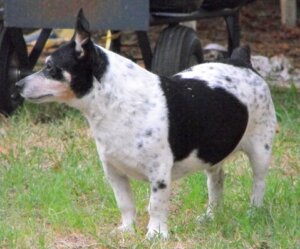Teddy Roosevelt Terrier: Everything About this Breed


Reviewed and approved by the biologist Samuel Sanchez
The Teddy Roosevelt Terrier is a small dog that wasn’t recognized as an official breed until 2019. This dog, in addition to being characterized by having the name of one of the most recognized former presidents of the United States, stands out for its courage and kindness.
In the same way, it’s an affectionate dog that behaves very well with children, which makes it ideal company for the family. On the other hand, despite having a lot of energy, it stands out for being a calm dog. In addition to the above, the Teddy Roosevelt Terrier is protective in nature and has well-developed herding instincts. Find out all about them below.
The origins of the Teddy Roosevelt Terrier
According to the American Kennel Club, during the 18th century, the British introduced breeds of dogs to the American continent such as the Smooth Fox Terrier, the Manchester Terrier, the Beagle, the whippet, the Italian greyhound, and the now-extinct White English Terrier in order to control rodent pests. Thus, over time, the crossing of these dogs would give way to the origin of the Teddy Roosevelt Terrier.
However, the dog was originally a variety of the rat terrier, but, in the 1990s, breeders worked to divide them into two breeds. On the one hand, the type A with the longest legs, the rat terrier; and on the other, the shorter-legged type B, the Teddy Roosevelt Terrier, which was named in honor of the former head of the American nation because he had dogs that were similar in appearance to this breed.
Characteristics of the Teddy Roosevelt Terrier
Regarding its appearance, the Teddy Roosevelt Terrier is a small dog with a rectangular structure and very short legs. Its weight can be between 3.6 and 11.3 kilograms, while its height ranges between 20 and 38 centimeters. This dog has a compact body, a narrow muzzle, expressive eyes, and a thick tail.
Likewise, it has a head proportional to its body, triangular-shaped ears, and a short, smooth coat that sticks to the skin. Besides, it can be a bicolor or tricolor dog, but the vast majority of specimens are white with brown or black spots on the body.
Character and behavior
As mentioned, this dog is excellent company in the home, since it’s a combination of energy and tranquility. In the same way, it’s a loyal, intelligent, and quite curious dog. Because of this, it’s easy to teach and also manages to adapt quickly to different environments.
However, it’s a dog that’s usually suspicious of strangers and is always aware when someone new comes home. Thus, due to its territorial nature, the Teddy Roosevelt Terrier turns out to be a good guard dog, in addition to being always very affectionate with its owners.
The training of the Teddy Roosevelt Terrier
It’s important to take advantage of the fast learning ability of the Teddy Roosevelt Terrier to give them some training to make them an obedient dog. The ideal thing is to start with its basic training as a puppy to get them to learn things like socialization or performing their “business” in a specific place.
In addition to the above, this dog loves fun and pleasing its owners, which makes it easier to train them. However, they also get bored easily, making it unwise to do very repetitive exercises. Due to its intelligence, it needs constant challenges.
In general, this companion animal responds very well to reward-based training methods. Positive reinforcement is helpful in their early years. Similarly, patience is very necessary when training them, as they’re dogs that mature slowly.
Positive reinforcement is based on rewarding the dog’s appropriate behaviors as soon as they’re performed.
Care measures
As with all pets, it’s necessary to take into account a series of care measures in order to ensure that your Teddy Roosevelt Terrier leads a healthy and happy life. In this sense, walking is a must, so that it can burn off excess energy. Likewise, it’s a great idea to practice sports and play interactive games with them.
On the other hand, in terms of grooming, the Teddy Roosevelt Terrier doesn’t require very special attention. You can brush their coat once a week, but you should brush it more frequently when they’re shedding, which happens once a year. Also, remember to clean the dog’s eyes, ears, and teeth, as well as bathing them when necessary.
When it comes to food, make sure you choose an ideal diet with the help of a veterinarian, who will know what’s best for your friend. You’ll need to get to know the food that’s good for the dog and provide it for them, in order to ensure good health and optimal energy
Teddy Roosevelt Terrier health
Because it’s a new breed, there’s no specific information about the diseases that the Teddy Roosevelt Terrier could suffer from. However, due to its closeness to the rat terrier, experts believe that this dog may suffer from some similar pathologies to it, such as bite problems, obesity, patella luxation, hip dysplasia and skin allergies.
Due to the above, always remember to take your pet for periodic check-ups with a veterinarian to detect or rule out any complications in their health. They’ll carry out the aforementioned care measures to positively influence the life of the dog. Don’t forget to pay close attention to any unusual reactions from your canine, however mild or sporadic.
In conclusion, the Teddy Roosevelt Terrier is excellent company. This loyal and playful dog will never hesitate to show you affection. In addition, with the correct training, it’ll become a very obedient pet. Likewise, they’ll always remain alert at home, without neglecting their calm and affable character.
The Teddy Roosevelt Terrier is a small dog that wasn’t recognized as an official breed until 2019. This dog, in addition to being characterized by having the name of one of the most recognized former presidents of the United States, stands out for its courage and kindness.
In the same way, it’s an affectionate dog that behaves very well with children, which makes it ideal company for the family. On the other hand, despite having a lot of energy, it stands out for being a calm dog. In addition to the above, the Teddy Roosevelt Terrier is protective in nature and has well-developed herding instincts. Find out all about them below.
The origins of the Teddy Roosevelt Terrier
According to the American Kennel Club, during the 18th century, the British introduced breeds of dogs to the American continent such as the Smooth Fox Terrier, the Manchester Terrier, the Beagle, the whippet, the Italian greyhound, and the now-extinct White English Terrier in order to control rodent pests. Thus, over time, the crossing of these dogs would give way to the origin of the Teddy Roosevelt Terrier.
However, the dog was originally a variety of the rat terrier, but, in the 1990s, breeders worked to divide them into two breeds. On the one hand, the type A with the longest legs, the rat terrier; and on the other, the shorter-legged type B, the Teddy Roosevelt Terrier, which was named in honor of the former head of the American nation because he had dogs that were similar in appearance to this breed.
Characteristics of the Teddy Roosevelt Terrier
Regarding its appearance, the Teddy Roosevelt Terrier is a small dog with a rectangular structure and very short legs. Its weight can be between 3.6 and 11.3 kilograms, while its height ranges between 20 and 38 centimeters. This dog has a compact body, a narrow muzzle, expressive eyes, and a thick tail.
Likewise, it has a head proportional to its body, triangular-shaped ears, and a short, smooth coat that sticks to the skin. Besides, it can be a bicolor or tricolor dog, but the vast majority of specimens are white with brown or black spots on the body.
Character and behavior
As mentioned, this dog is excellent company in the home, since it’s a combination of energy and tranquility. In the same way, it’s a loyal, intelligent, and quite curious dog. Because of this, it’s easy to teach and also manages to adapt quickly to different environments.
However, it’s a dog that’s usually suspicious of strangers and is always aware when someone new comes home. Thus, due to its territorial nature, the Teddy Roosevelt Terrier turns out to be a good guard dog, in addition to being always very affectionate with its owners.
The training of the Teddy Roosevelt Terrier
It’s important to take advantage of the fast learning ability of the Teddy Roosevelt Terrier to give them some training to make them an obedient dog. The ideal thing is to start with its basic training as a puppy to get them to learn things like socialization or performing their “business” in a specific place.
In addition to the above, this dog loves fun and pleasing its owners, which makes it easier to train them. However, they also get bored easily, making it unwise to do very repetitive exercises. Due to its intelligence, it needs constant challenges.
In general, this companion animal responds very well to reward-based training methods. Positive reinforcement is helpful in their early years. Similarly, patience is very necessary when training them, as they’re dogs that mature slowly.
Positive reinforcement is based on rewarding the dog’s appropriate behaviors as soon as they’re performed.
Care measures
As with all pets, it’s necessary to take into account a series of care measures in order to ensure that your Teddy Roosevelt Terrier leads a healthy and happy life. In this sense, walking is a must, so that it can burn off excess energy. Likewise, it’s a great idea to practice sports and play interactive games with them.
On the other hand, in terms of grooming, the Teddy Roosevelt Terrier doesn’t require very special attention. You can brush their coat once a week, but you should brush it more frequently when they’re shedding, which happens once a year. Also, remember to clean the dog’s eyes, ears, and teeth, as well as bathing them when necessary.
When it comes to food, make sure you choose an ideal diet with the help of a veterinarian, who will know what’s best for your friend. You’ll need to get to know the food that’s good for the dog and provide it for them, in order to ensure good health and optimal energy
Teddy Roosevelt Terrier health
Because it’s a new breed, there’s no specific information about the diseases that the Teddy Roosevelt Terrier could suffer from. However, due to its closeness to the rat terrier, experts believe that this dog may suffer from some similar pathologies to it, such as bite problems, obesity, patella luxation, hip dysplasia and skin allergies.
Due to the above, always remember to take your pet for periodic check-ups with a veterinarian to detect or rule out any complications in their health. They’ll carry out the aforementioned care measures to positively influence the life of the dog. Don’t forget to pay close attention to any unusual reactions from your canine, however mild or sporadic.
In conclusion, the Teddy Roosevelt Terrier is excellent company. This loyal and playful dog will never hesitate to show you affection. In addition, with the correct training, it’ll become a very obedient pet. Likewise, they’ll always remain alert at home, without neglecting their calm and affable character.
All cited sources were thoroughly reviewed by our team to ensure their quality, reliability, currency, and validity. The bibliography of this article was considered reliable and of academic or scientific accuracy.
- Teddy Roosevelt Terrier. American Kennel Club. Recogido el 14 de agosto de 2021 de: https://www.akc.org/dog-breeds/teddy-roosevelt-terrier/
- Descripción general de los problemas de salud de Teddy Roosevelt Terrier. American Teddy Roosevelt Terrier Club. Recogido el 14 de agosto de 2021: http://www.teddyrooseveltterrier.org/health-overview.html
This text is provided for informational purposes only and does not replace consultation with a professional. If in doubt, consult your specialist.








